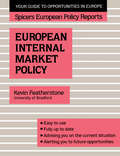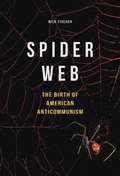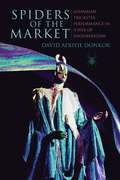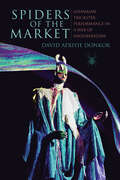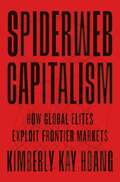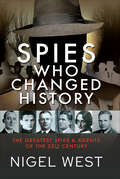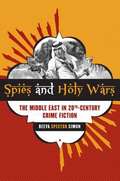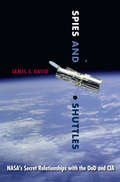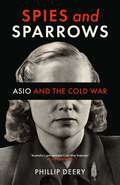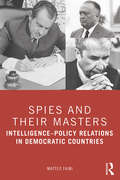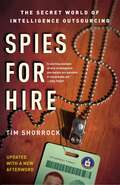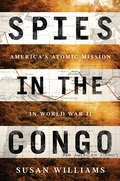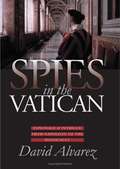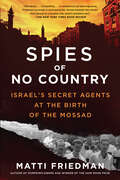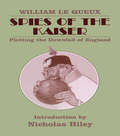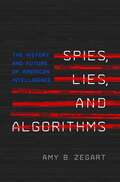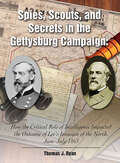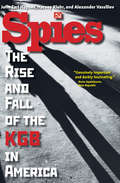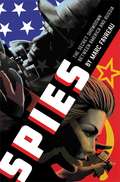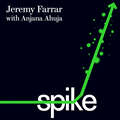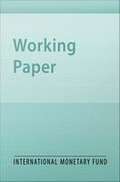- Table View
- List View
Spicers;Europ Internal Mar Pol
by Featherstone KevinOffers comprehensive information about "1992", presented in a clear and readily accessible format. In an extensive introduction, it explains how policy programmes emerged and discusses the implications for the future.
Spider Web: The Birth of American Anticommunism
by Nick FischerThe McCarthy-era witch hunts marked the culmination of an anticommunist crusade launched after the First World War. With Bolshevism triumphant in Russia and public discontent shaking the United States, conservatives at every level of government and business created a network dedicated to sweeping away the "spider web" of radicalism they saw threatening the nation. In this groundbreaking study, Nick Fischer shines a light on right-wing activities during the interwar period. Conservatives, eager to dispel communism's appeal to the working class, railed against a supposed Soviet-directed conspiracy composed of socialists, trade unions, peace and civil liberties groups, feminists, liberals, aliens, and Jews. Their rhetoric and power made for devastating weapons in their systematic war for control of the country against progressive causes. But, as Fischer shows, the term spider web far more accurately described the anticommunist movement than it did the makeup and operations of international communism. Fischer details how anticommunist myths and propaganda influenced mainstream politics in America, and how its ongoing efforts paved the way for the McCarthyite Fifties--and augured the conservative backlash that would one day transform American politics.
Spiders of the Market, Enhanced Ebook: Ghanaian Trickster Performance in a Web of Neoliberalism
by David Afriyie DonkorThe Ghanaian trickster-spider, Ananse, is a deceptive figure full of comic delight who blurs the lines of class, politics, and morality. David Afriyie Donkor identifies social performance as a way to understand trickster behavior within the shifting process of political legitimization in Ghana, revealing stories that exploit the social ideologies of economic neoliberalism and political democratization. At the level of policy, neither ideology was completely successful, but Donkor shows how the Ghanaian government was crafty in selling the ideas to the people, adapting trickster-rooted performance techniques to reinterpret citizenship and the common good. Trickster performers rebelled against this takeover of their art and sought new ways to out trick the tricksters.
Spiders of the Market: Ghanaian Trickster Performance in a Web of Neoliberalism (African Expressive Cultures)
by David Afriyie DonkorAn analysis of the trickster spider character from West African folklore, performance, and Ghanian politics.The Ghanaian trickster-spider, Ananse, is a deceptive figure full of comic delight who blurs the lines of class, politics, and morality. David Afriyie Donkor identifies social performance as a way to understand trickster behavior within the shifting process of political legitimization in Ghana, revealing stories that exploit the social ideologies of economic neoliberalism and political democratization. At the level of policy, neither ideology was completely successful, but Donkor shows how the Ghanaian government was crafty in selling the ideas to the people, adapting trickster-rooted performance techniques to reinterpret citizenship and the common good. Trickster performers rebelled against this takeover of their art and sought new ways to out trick the tricksters.“A precise and inviting appeal to political economy, performance, and the enduring relevance of the cultural and archetypal trickster.” —D. Soyini Madison, Northwestern University“David Afriyie Donkor’s experience as a theatre artist and director supports the rich political economic component that frames this analysis of performance and performance traditions for broad audiences.” —Jesse Weaver Shipley, Haverford College“By sharing the performance experiences, rather than texts, Donkor accomplishes the challenging task of introducing rare theatre performances in a particularly compelling context for a Western readership in a global age.” —Theatre Survey“Overall, as a Ghanaian actor and director as well as a scholar, Donkor’s cultural insider analyses of ananse theatre within the space of political economy make important contributions and interventions to the discourses on performance (theory) and neoliberalism and their interaction in Ghana and Africa.” —African Studies Review
Spiderweb Capitalism: How Global Elites Exploit Frontier Markets
by Kimberly Kay HoangA behind-the-scenes look at how the rich and powerful use offshore shell corporations to conceal their wealth and make themselves richerIn 2015, the anonymous leak of the Panama Papers brought to light millions of financial and legal documents exposing how the superrich hide their money using complex webs of offshore vehicles. Spiderweb Capitalism takes you inside this shadow economy, uncovering the mechanics behind the invisible, mundane networks of lawyers, accountants, company secretaries, and fixers who facilitate the illicit movement of wealth across borders and around the globe.Kimberly Kay Hoang traveled more than 350,000 miles and conducted hundreds of in-depth interviews with private wealth managers, fund managers, entrepreneurs, C-suite executives, bankers, auditors, and other financial professionals. She traces the flow of capital from offshore funds in places like the Cayman Islands, Samoa, and Panama to special-purpose vehicles and holding companies in Singapore and Hong Kong, and how it finds its way into risky markets onshore in Vietnam and Myanmar. Hoang reveals the strategies behind spiderweb capitalism and examines the moral dilemmas of making money in legal, financial, and political gray zones.Dazzlingly written, Spiderweb Capitalism sheds critical light on how global elites capitalize on risky frontier markets, and deepens our understanding of the paradoxical ways in which global economic growth is sustained through states where the line separating the legal from the corrupt is not always clear.
Spielarten des politischen Konsums: Vom Boykott zum Buykotting
by Carolin V. ZorellDieses Buch bietet eine Analyse der Politik des Konsums und zeigt, wie der "gebildete Verbraucher" eine entscheidende Rolle bei der Förderung verantwortungsvoller Marktpraktiken und des Konsums spielt. Auf der Grundlage einer umfassenden interdisziplinären Perspektive untersucht es das Ausmaß, die Triebkräfte und die Verbindungen von Boykott, Kaufboykott, Kennzeichnungssystemen und sozialer Verantwortung von Unternehmen (CSR) in 20 europäischen Ländern. Eine zentrale Frage ist, ob makro-gesellschaftliche Orientierungsmuster hinsichtlich der Rolle des Staates, der Unternehmen und der Bürger individuelle und länderübergreifende Unterschiede beim Boykottieren und beim Kaufverbot erklären können. Wie das Buch zeigt, gibt es nicht nur einen Typus des "politischen Verbrauchers", sondern mehrere, und ihr Auftreten steht in direktem Zusammenhang mit nationalen Variationen von Kennzeichnungssystemen und der sozialen Verantwortung von Unternehmen. Die Verbraucher brauchen Anhaltspunkte und Informationen über die politischen Hintergründe ihrer Einkäufe, und die politischen Entscheidungsträger müssen diesem Bedarf durch politische Maßnahmen Rechnung tragen, die den nationalen Mustern in den Ansichten über Zusammenarbeit und Marktbeziehungen entsprechen.
Spies
by Richard PlattExamines the history, motives, and actions of various spies, both criminal and governmental.
Spies Who Changed History: The Greatest Spies & Agents of the 20th Century
by Nigel WestSpies have made an extraordinary impact on the history of the 20th Century, but fourteen in particular can be said to have been demonstrably important. As one might expect, few are household names, and it is only with the benefit of recently declassified files that we can now fully appreciate the nature of their contribution. The criteria for selection have been the degree to which each can now be seen to have had a very definite influence on a specific course of events, either directly, by passing vital classified material, or indirectly, by organizing or managing a group of spies. Those selected were active in the First World War, the inter-war period, the Second World War, the Cold War and even the post-Cold War era. These include Walther Dewé who formed a spy ring in German-occupied Belgium during the First World War. This train-watching network, known as ‘White Lady’, reported on German troop deployments and possible weaknesses in the German defences. Extending its operations into northern France, the ring provided 75 per cent of the information received by GHQ, British Expeditionary Force. By the time of the Armistice in 1918, Dewé’s group had a staggering 1,300 members. Olga Gray, the 27-year-old daughter of a Daily Mail journalist, was employed as a secretary by the Communist Party of Great Britain. In 1931 she undertook a mission for MI5 to penetrate the organization and discover its secret channel of communication with Moscow. Gray learned that the Party’s cipher was based on Treasure Island and this breakthrough enabled the Party’s messages to be read by Whitehall cryptographers. Renato Levi, an Italian playboy, was the longest-serving British agent of the Second World War and is credited with creating the concept of strategic deception. While operating in Cairo as a double agent working for the Abwehr and the British he was instrumental in misleading the Axis about Allied strength across the Middle East and helped Montgomery achieve his victory over Rommel’s Afrika Korps at El Alamein. So successful was Levi in this and other deceptions, he was employed to persuade the Germans that the D-Day landings in Normandy were a diversionary feint, in anticipation of an invasion in the Pas-de-Calais. These, and other surprising stories, are revealed in this fascinating insight into a secret world inhabited by mysterious and shadowy characters, all of whom, though larger than life, really did exist.
Spies and Holy Wars: The Middle East in 20th-Century Crime Fiction
by Simon Reeva SpectorIlluminating a powerful intersection between popular culture and global politics, Spies and Holy Wars draws on a sampling of more than eight hundred British and American thrillers that are propelled by the theme of jihad--an Islamic holy war or crusade against the West. Published over the past century, the books in this expansive study encompass spy novels and crime fiction, illustrating new connections between these genres and Western imperialism. Demonstrating the social implications of the popularity of such books, Reeva Spector Simon covers how the Middle Eastern villain evolved from being the malleable victim before World War II to the international, techno-savvy figure in today's crime novels. She explores the impact of James Bond, pulp fiction, and comic books and also analyzes the ways in which world events shaped the genre, particularly in recent years. Worldwide terrorism and economic domination prevail as the most common sources of narrative tension in these works, while military "tech novels" restored the prestige of the American hero in the wake of post-Vietnam skepticism. Moving beyond stereotypes, Simon examines the relationships between publishing trends, political trends and popular culture at large--giving voice to the previously unexamined truths that emerge from these provocative page-turners.
Spies and Shuttles: NASA's Secret Relationships with the DoD and CIA
by James E. DavidRevealing the connections between NASA and the United States defense communityIn this real life spy saga, James E. David reveals the extensive and largely hidden interactions between NASA and U.S. defense and intelligence departments. The story begins with the establishment of NASA in 1958 and follows the agency through its growth, not only in scope but also in complexity.In Spies and Shuttles, David digs through newly declassified documents to ultimately reveal how NASA became a strange bedfellow to the Department of Defense (DoD) and the Central Intelligence Agency (CIA). He tracks NASA’s early cooperation—supplying cover stories for covert missions, analyzing the Soviet space program, providing weather and other scientific data from its satellites, and monitoring missile tests—that eventually devolved into NASA’s reliance on DoD for political and financial support for the Shuttle. David also examines the restrictions imposed on such activities as photographing the Earth from space and the intrusive review mechanisms to ensure compliance.The ties between NASA and the intelligence community have historically remained unexplored, and David’s riveting book is the first to investigate the twists and turns of this labyrinthine relationship.
Spies and Sparrows: ASIO and the Cold War
by Phillip DeeryIn the wake of the Second World War and the realisation that the Soviet Union had set up extensive espionage networks around the world, Australia responded by establishing its own spy-hunting agency: ASIO. By the 1950s its counterespionage activities were increasingly supplemented by attempts at countersubversion - identifying individuals and organisations suspected of activities that threatened national security. In doing so, it crossed the boundary from being a professional agency that collected, evaluated and transmitted intelligence, to a sometimes politicised but always shadowy presence, monitoring not just communists but also peace activists, scientists, academics, journalists and writers. The human cost of ASIO's monitoring of domestic dissenters is difficult to measure. It is only through recovering the hidden histories of personal damage inflicted by ASIO on both lawful protesters and, in some cases, its own agents, that the extent can be revealed. By interrogating the roles of eight individuals intimately involved in the conduct of the Cold War, and drawing on many years of research, Phillip Deery's Spies and Sparrows: ASIO and the Cold War shines a powerful new light on the history of ASIO and raises important and enduring questions about the nature and impact of a state's surveillance of its citizens.
Spies and Their Masters: Intelligence–Policy Relations in Democratic Countries
by Matteo FainiThis book delves into the secret histories of the CIA, the FBI, and British and Italian intelligence to study how policymakers can control intelligence agencies and when these agencies will try to remove their own government. For every government they serve, intelligence agencies are both a threat and a necessity. They often provide vital information for national security, but the secrets they possess can also be used against their own masters. This book introduces subversion paradox theory to provide a social scientific explanation of the unequal power dynamic resulting from an often fraught relationship between agencies and their ‘masters’. The author also makes a case for the existence of ‘deep state’ conspiracies, including in highly developed democracies, and cautions those who denounce their existence that trying to control intelligence by politicizing it is likely to backfire. An important intervention in the field of intelligence studies, this book will be indispensable for intelligence professionals and policymakers in understanding and bridging the cultural divide between these two groups. It will also make for a fascinating and informative read to scholars and researchers of diplomacy, foreign policy, international relations, strategic and defence studies, security studies, political studies, policymaking and comparative politics.
Spies for Hire: The Secret World of Intelligence Outsourcing
by Tim ShorrockIn Spies for Hire, investigative reporter Tim Shorrock lifts the veil off a major story the government doesn't want us to know about -- the massive outsourcing of top secret intelligence activities to private-sector contractors. Running spy networks overseas. Tracking down terrorists in the Middle East. Interrogating enemy prisoners. Analyzing data from spy satellites and intercepted phone calls. All of these are vital intelligence tasks that traditionally have been performed by government officials accountable to Congress and the American people. But that is no longer the case. Starting during the Clinton administration, when intelligence budgets were cut drastically and privatization of government services became national policy, and expanding dramatically in the wake of 9/11, when the CIA and other agencies were frantically looking to hire analysts and linguists, the Intelligence Community has been relying more and more on corporations to perform sensitive tasks heretofore considered to be exclusively the work of federal employees. This outsourcing of intelligence activities is now a $50 billion-a-year business that consumes up to 70 percent of the U. S. intelligence budget. And it's a business that the government has tried hard to keep under wraps. Drawing on interviews with key players in the Intelligence-Industrial Complex, contractors' annual reports and public filings with the government, and on-the-spot reporting from intelligence industry conferences and investor briefings,Spies for Hire provides the first behind-the-scenes look at this new way of spying. Shorrock shows how corporations such as Booz Allen Hamilton, Lockheed Martin, SAIC, CACI International, and IBM have become full partners with the CIA, the National Security Agency, and the Pentagon in their most sensitive foreign and domestic operations. He explores how this partnership has led to wasteful spending and threatens to erode the privacy protections and congressional oversight so important to American democracy. Shorrock exposes the kinds of spy work the private sector is doing, such as interrogating prisoners in Iraq, managing covert operations, and collaborating with the National Security Agency to eavesdrop on Americans' overseas phone calls and e-mails. And he casts light on a "shadow Intelligence Community" made up of former top intelligence officials who are now employed by companies that do this spy work, such as former CIA directors George Tenet and James Woolsey. Shorrock also traces the rise of Michael McConnell from his days as head of the NSA to being a top executive at Booz Allen Hamilton to returning to government as the nation's chief spymaster. From CIA covert actions to NSA eavesdropping, from Abu Ghraib to Guantánamo, from the Pentagon's techno-driven war in Iraq to the coming global battles over information dominance and control of cyberspace, contractors are doing it all. Spies for Hire goes behind today's headlines to highlight how private corporations are aiding the growth of a new and frightening national surveillance state.
Spies in the Congo: America's Atomic Mission in World War II
by Susan WilliamsIn the 1940s, the brightest minds of the United States and Nazi Germany raced to West Africa with a single mission: to secure the essential ingredient of the atomic bomb-and to make sure nobody saw them doing itAlbert Einstein told President Franklin D. Roosevelt in 1939 that the world's only supply of uniquely high-quality uranium ore-the key ingredient for bomb- could be found in the Katanga province of the Belgian Congo at the Shinkolobwe Mine. Once the US Manhattan Project was committed to developing atomic weapons for the war against Germany and Japan, the rush to procure this uranium became a top priority-one deemed "vital to the welfare of the United States.”But covertly exporting it from Africa posed a major risk: the ore had to travel via a spy-infested Angolan port or 1,500 miles by rail through the Congo, and then be shipped by boats or Pan Am Clippers to safety in the United States. It could be poached or smuggled at any point on the orders of Nazi Germany. To combat that threat, the US Office of Strategic Services sent in a team of intrepid spies, led by Wilbur Owings "Dock” Hogue, to be America's eyes and ears and to protect its most precious and destructive cargo. Packed with newly discovered details from American and British archives, this is the gripping, true story of the unsung heroism of a handful of good men-and one woman-in colonial Africa who risked their lives in the fight against fascism and helped deny Hitler his atomic bomb.
Spies in the Vatican: Espionage and Intrigue from Napoleon to the Holocaust
by David J. AlvarezThe part played by the Catholic Church in International espionage.
Spies of No Country: Secret Lives at the Birth of Israel
by Matti FriedmanAward-winning writer Matti Friedman’s tale of Israel’s first spies has all the tropes of an espionage novel, including duplicity, betrayal, disguise, clandestine meetings, the bluff, and the double bluff--but it’s all true. The four spies at the center of this story were part of a ragtag unit known as the Arab Section, conceived during World War II by British spies and Jewish militia leaders in Palestine. Intended to gather intelligence and carry out sabotage and assassinations, the unit consisted of Jews who were native to the Arab world and could thus easily assume Arab identities. In 1948, with Israel’s existence in the balance during the War of Independence, our spies went undercover in Beirut, where they spent the next two years operating out of a kiosk, collecting intelligence, and sending messages back to Israel via a radio whose antenna was disguised as a clothesline. While performing their dangerous work these men were often unsure to whom they were reporting, and sometimes even who they’d become. Of the dozen spies in the Arab Section at the war’s outbreak, five were caught and executed. But in the end the Arab Section would emerge, improbably, as the nucleus of the Mossad, Israel’s vaunted intelligence agency.Spies of No Country is about the slippery identities of these young spies, but it’s also about Israel’s own complicated and fascinating identity. Israel sees itself and presents itself as a Western nation, when in fact more than half the country has Middle Eastern roots and traditions, like the spies of this story. And, according to Friedman, that goes a long way toward explaining the life and politics of the country, and why it often baffles the West. For anyone interested in real-life spies and the paradoxes of the Middle East, Spies of No Country is an intimate story with global significance.
Spies of the Kaiser: Plotting the Downfall of England (Classics Of Espionage Ser.)
by William Le QueuxLe Queux was the first and most prolific of all British spy writers, but Spies of the Kaiser was not just another tale of scheming foreigners and plucky British heroes, for this paranoid tale of German secret agents plotting the invasion of Britain played a major part in the formation of MI5, Britain's counter-espionage organisation. In his introduction, intelligence historian Nicholas Hiley explains how Le Queux's powerful blend of fact and fiction inspired a whole generation of British secret service officers, and led MI5 in a nation-wide hunt for a non-existent enemy.
Spies, Lies, and Algorithms: The History and Future of American Intelligence
by Amy B. ZegartA riveting account of espionage for the digital age, from one of America’s leading intelligence expertsSpying has never been more ubiquitous—or less understood. The world is drowning in spy movies, TV shows, and novels, but universities offer more courses on rock and roll than on the CIA and there are more congressional experts on powdered milk than espionage. This crisis in intelligence education is distorting public opinion, fueling conspiracy theories, and hurting intelligence policy. In Spies, Lies, and Algorithms, Amy Zegart separates fact from fiction as she offers an engaging and enlightening account of the past, present, and future of American espionage as it faces a revolution driven by digital technology.Drawing on decades of research and hundreds of interviews with intelligence officials, Zegart provides a history of U.S. espionage, from George Washington’s Revolutionary War spies to today’s spy satellites; examines how fictional spies are influencing real officials; gives an overview of intelligence basics and life inside America’s intelligence agencies; explains the deadly cognitive biases that can mislead analysts; and explores the vexed issues of traitors, covert action, and congressional oversight. Most of all, Zegart describes how technology is empowering new enemies and opportunities, and creating powerful new players, such as private citizens who are successfully tracking nuclear threats using little more than Google Earth. And she shows why cyberspace is, in many ways, the ultimate cloak-and-dagger battleground, where nefarious actors employ deception, subterfuge, and advanced technology for theft, espionage, and information warfare.A fascinating and revealing account of espionage for the digital age, Spies, Lies, and Algorithms is essential reading for anyone who wants to understand the reality of spying today.
Spies, Scouts, and Secrets in the Gettysburg Campaign: How the Critical Role of Intelligence Impacted the Outcome of Lee's Invasion of the North, June–July 1863
by Thomas J. Ryan&“A fascinating book, and the most detailed account you will find about intelligence operations during the Gettysburg campaign.&” —Dr. Vince Houghton, Historian/Curator, International Spy Museum, Washington, DC As intelligence experts have long asserted, &“Information in regard to the enemy is the indispensable basis of all military plans.&” Despite the thousands of books and articles written about Gettysburg, Tom Ryan&’s groundbreaking Spies, Scouts, and Secrets in the Gettysburg Campaign is the first to offer a unique and incisive comparative study of intelligence operations during what many consider the war&’s decisive campaign. Based upon years of indefatigable research, the author evaluates how Gen. Robert E. Lee used intelligence resources, including cavalry, civilians, newspapers, and spies to gather information about Union activities during his invasion of the North in June and July 1863, and how this information guided Lee&’s decision-making. Simultaneously, Ryan explores the effectiveness of the Union Army of the Potomac&’s intelligence and counterintelligence operations. Both Maj. Gens. Joe Hooker and George G. Meade relied upon cavalry, the Signal Corps, and an intelligence staff known as the Bureau of Military Information that employed innovative concepts to gather, collate, and report vital information from a variety of sources.
Spies: The Rise and Fall of the KGB in America
by John Earl Haynes Harvey Klehr Alexander Vassiliev&“This important new book . . . based on archival material . . . shows the huge extent of Soviet espionage activity in the United States during the 20th century&” (The Telegraph). Based on KGB archives that have never been previously released, this stunning book provides the most complete account of Soviet espionage in America ever written. In 1993, former KGB officer Alexander Vassiliev was permitted unique access to Stalin-era records of Soviet intelligence operations against the United States. Years later, Vassiliev retrieved his extensive notebooks of transcribed documents from Moscow. With these notebooks, John Earl Haynes and Harvey Klehr have meticulously constructed a new and shocking historical account. Along with valuable insight into Soviet espionage tactics and the motives of Americans who spied for Stalin, Spies resolves many long-standing intelligence controversies. The book confirms that Alger Hiss cooperated with the Soviets over a period of years, that journalist I. F. Stone worked on behalf of the KGB in the 1930s, and that Robert Oppenheimer was never recruited by Soviet intelligence. Uncovering numerous American spies who never came under suspicion, this essential volume also reveals the identities of the last unidentified American nuclear spies. And in a gripping introduction, Vassiliev tells the story of his notebooks and his own extraordinary life.
Spies: The Secret Showdown Between America and Russia
by Marc FavreauA thrilling account of the Cold War spies and spycraft that changed the course of history, perfect for readers of Bomb and The Boys Who Challenged Hitler.The Cold War spanned five decades as America and the USSR engaged in a battle of ideologies with global ramifications. Over the course of the war, with the threat of mutually assured nuclear destruction looming, billions of dollars and tens of thousands of lives were devoted to the art and practice of spying, ensuring that the world would never be the same.Rife with intrigue and filled with fascinating historical figures whose actions shine light on both the past and present, this timely work of narrative nonfiction explores the turbulence of the Cold War through the lens of the men and women who waged it behind closed doors, and helps explain the role secret and clandestine operations have played in America's history and its national security.
Spike: The Virus vs. The People - the Inside Story
by Anjana Ahuja Jeremy Farrar***THE TOP 5 SUNDAY TIMES BESTSELLER***A pulse-racing journey through the science and politics of the pandemic. Did the UK government really 'follow the science' throughout the Covid-19 pandemic, as it claims?The Coronavirus pandemic has devastated lives and livelihoods around the world - and continues to do so. These personal tragedies will, and must, be told and heard. There is, however, also a truthful and objective scientific narrative to be written about how the virus played out and how the world set about dealing with it. Spike is that story -from the inside. Its author, Jeremy Farrar, is one of the UK's leading scientists and a - member of the SAGE emergency committee.As head of the Wellcome Trust, and an expert in emerging infectious diseases, Jeremy Farrar was one of the first people in the world to hear about a mysterious new respiratory disease in China - and to learn that it could readily spread between people. Farrar describes how it feels as one of the key scientists at the sharp end of a fastmoving situation, when complex decisions must be made quickly amid great uncertainty. His book casts light on the UK government's claims to be 'following the science' in its response to the virus, and is informed not just by Farrar's views but by interviews with other top scientists and political figures.Farrar, who has spent his career on the frontlines of epidemics including Nipah virus in Malaysia, bird flu in Vietnam and Ebola in West Africa, also reflects on the wider issues of Covid-19: the breath-taking scientific advances in creating tests, treatments and vaccines; the challenge to world leaders to respond for the global good and the need to address inequalities that hold back success against the virus. All these shape how the world ultimately fares not just against Covid-19, but against all the major health challenges we face globally.
Spillover Effects and the East African Community
by Paulo Drummond Gustavo RamirezThe East African Community (EAC) countries--Kenya, Tanzania, Uganda, and Rwanda--have been affected by the global financial crisis and global recession. the fall in global demand and inflows and tighter liquidity conditions abroad affected the countries in this region as elsewhere in sub-Saharan Africa. But how hard have countries in the EAC been hit? Have the spillovers from the global crisis affected countries in the region as much as other countries in the sub-Saharan region? Have the transmission channels or magnitudes of the spillovers been different across EAC countries? How can these countries return quickly to a path of sustained high growth? What is the role for policy? Would acceleration of regional integration and policy coordination help achieve this goal? Would it make the region less susceptible to shocks? This paper focus on the EAC countries and attempts to address these questions.
Spillovers of Domestic Shocks: Will They Counteract the "Great Moderation"?
by Ashoka Mody Alina CarareA report from the International Monetary Fund.
